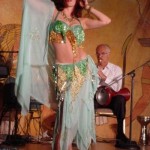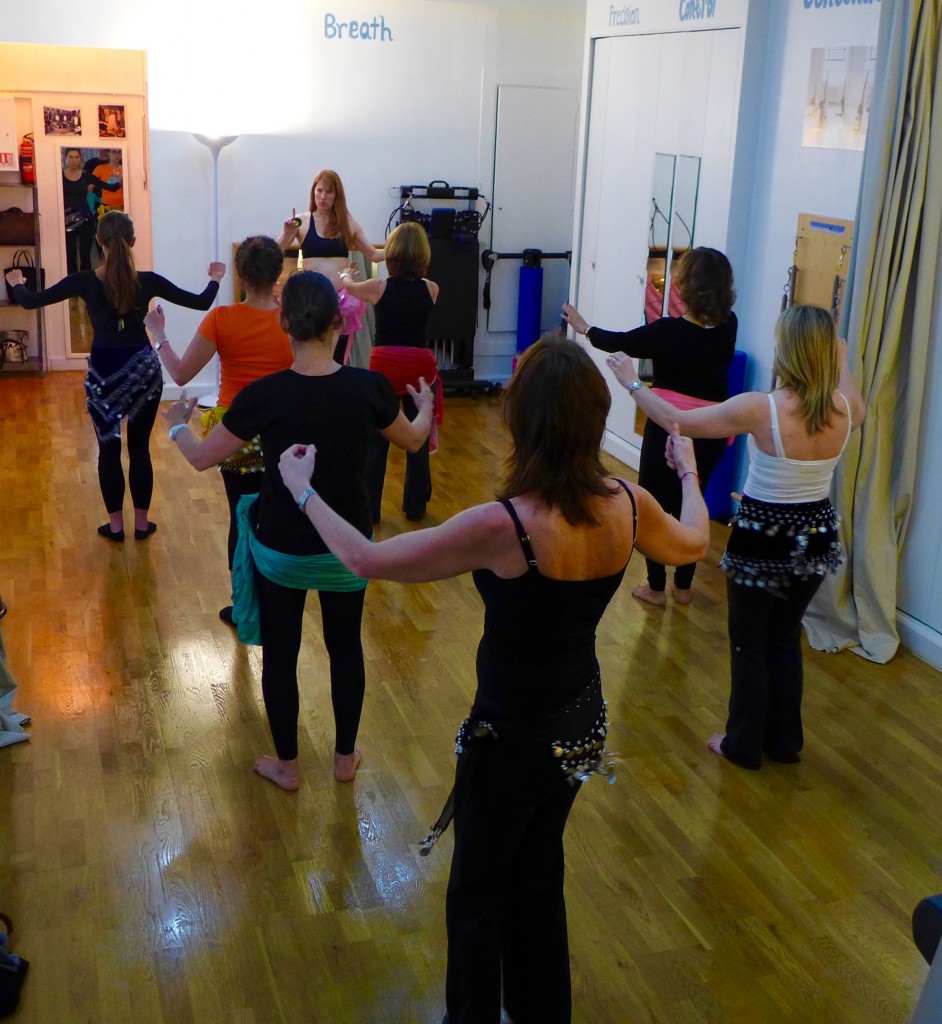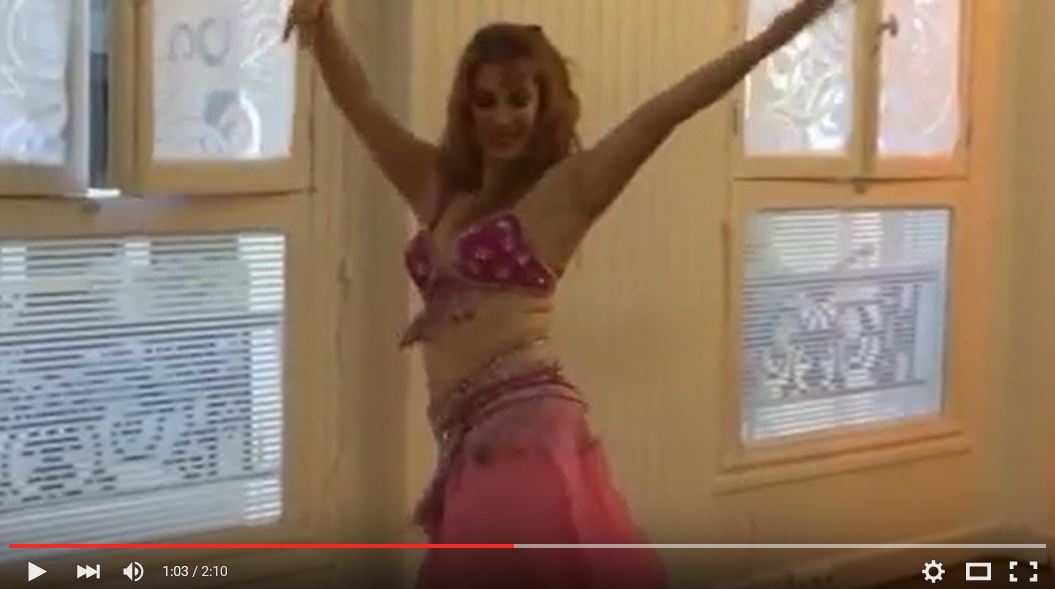Belly dance is the perfect complement to Pilates. But why?
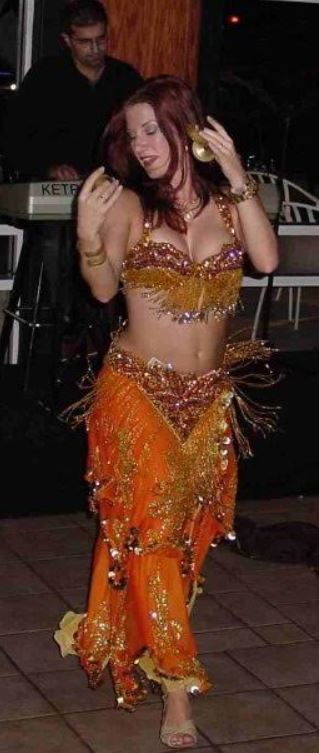 I started belly dancing in 1996 for two reasons: First, I already loved the art form and I had a shot at dancing at the world-famous Caesar’s Palace in Las Vegas. Second, because I started having injuries from doing ballet, jazz and modern dance since I was five years old and my body needed a break! Belly dance felt good to do, it felt natural like it is the kind of movements my body was designed to do. The tendonitis in my ankle started to ease and my lower back and hip tightness went away, so I kept on belly dancing for three more years at Caesar’s Palace. At this point, I hadn’t even heard of Pilates yet.
I started belly dancing in 1996 for two reasons: First, I already loved the art form and I had a shot at dancing at the world-famous Caesar’s Palace in Las Vegas. Second, because I started having injuries from doing ballet, jazz and modern dance since I was five years old and my body needed a break! Belly dance felt good to do, it felt natural like it is the kind of movements my body was designed to do. The tendonitis in my ankle started to ease and my lower back and hip tightness went away, so I kept on belly dancing for three more years at Caesar’s Palace. At this point, I hadn’t even heard of Pilates yet.
I first heard of Pilates after moving to and performing in New York City in 2000. One of my belly dance colleagues taught Pilates and showed me the studio she rented in midtown. I thought the equipment looked a bit bizarre and couldn’t quite understand fully how it helped her dancing. Later that year I started working as a Physical Therapy assistant for Westside Dance Physical Therapy with Marika Molnar. I was performing every weekend in different NY clubs and restaurants, and wanted to do something else during the weekdays. Plus, I got to work with NYCB and ABT ballerinas! Here were these strange machines again and Marika and the other PTs were using them to rehab and strengthen these elite dancers. I was intrigued. I taught the PTs a bellydance class as their in-house education, which was hilarious and they loved it.
It was while I was working at the Westside Dance clinic that I injured my back lifting a heavy box in a small office, while using bad body mechanics. I was devastated. I heard a strange cracking noise in my back and then searing pain. I couldn’t bend over without pain, but happily, the only thing that made my back feel better was belly dancing. At least I had no income loss. Marika Molnar started to rehab me with Pilates and electro stimulation. I started on the Cadillac and she progressed me to the reformer. My back got better and I was hooked. I immediately started taking classes all over town and jumped into the process of getting myself certified. I have continued to do Pilates and Bellydance and haven’t had back pain in the fifteen years since that injury. I only wish I had started Pilates earlier in my dance career and could have prevented all those previous injuries!
I no longer perform professionally but I do teach belly dance workshops in my studio in Paris, France to my Pilates students. The two movement vocabularies are quite complimentary in both differences and similarities. The focus of belly dance is that the movements are in isolation. One must learn how to move the hips without moving the rest of the body and vice versa isolating the chest, the head, and the shoulders and arms moving individually and at the same time. The key to success in this isolation is elongation of the spine. We bend the knees and stretch the ribcage away from the pelvis to create as much space as possible, and then the isolations are easier. Belly dancers demonstrate their proficiency in performance by balancing things on their head while dancing, like a sword, a cane or a tray of lit candles. The idea is that the head remains perfectly still while the rest of the body undulates with a wide range of motion.
The pelvis moves in all directions in belly dance but the focus is primarily on the lateral movements. This is something that I find is lacking in the Pilates repertoire and most people are really tight in their lateral hips from crossing their legs and sitting all day. In Pilates we concentrate on keeping the hips level and stable when using the legs but in belly dance we use the legs like pistons to move the pelvis up and down which stretches tight, short and underused muscles in the low back, hips and sides of the body. In Belly dance we also work on releasing and contracting the abdominal muscles and the pelvic floor. This can be extremely helpful in working with Pilates clients (and teachers!) who can be hypertonic in their pelvic floor from holding their stomach muscles in contraction all the time. There is real abdominal control when you can contract and release the muscles while doing hip circles or an undulation, for example – plus, it accentuates the movements! We teach a similar hip circle during the corkscrew or Hip Circles in Pilates but without the contract/release of the abdominals. This technique also aids in digestion and elimination.
Since we dance standing during the whole class, it’s great for older women with osteoporosis as it offers some impact for the bones as well as balance training. The arms are held up at shoulder level or overhead nearly all the time, so shoulder stabilization is required as well as lengthening of the cervical spine to create a graceful dance posture. You’d be amazed at how people’s posture changes when you place a sequin covered cane on their head to balance. Their spine lengthens right up!
There is also a focus in belly dance on spinal articulation with undulations (called the Camel), which is similar to doing a standing articulated bridge in Pilates. The difference being that in belly dance we contract and release the abdominals to accentuate the spinal articulation. We also work on ribcage isolations in all directions, which is similar to jazz dance but also found in Mermaid and twisting movements in Pilates. Ribcage circles loosen up inflexible thoracic spines in the same way that hip circles loosen up inflexible lumbar spines.
Above all, the most important thing is that belly dance is meant to be a physical interpretation of the music, so we just have fun and dance! (And continue doing our Pilates, of course.)
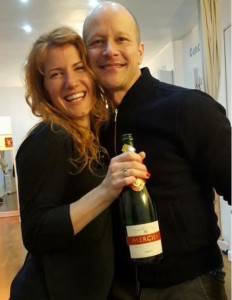 Erin started formal dance training at age five, culminating in her dance degree from University of North Carolina Greensboro studying both Classical and Modern Dance. She started belly dancing in Las Vegas with an Egyptian teacher in 1996 and became a featured performer at world renown Caesar’s Palace Las Vegas where she danced for three years. Erin then expanded her horizons – dancing with top Middle Eastern bands in several of the most popular nightclubs and restaurants in New York City, Orlando and Tampa for several years. Over her professional career Erin has also performed in Japan, Amsterdam, Paris and Cairo while giving workshops and seminars that explore the history of bellydance, teach technique and choreography to students in three countries.
Erin started formal dance training at age five, culminating in her dance degree from University of North Carolina Greensboro studying both Classical and Modern Dance. She started belly dancing in Las Vegas with an Egyptian teacher in 1996 and became a featured performer at world renown Caesar’s Palace Las Vegas where she danced for three years. Erin then expanded her horizons – dancing with top Middle Eastern bands in several of the most popular nightclubs and restaurants in New York City, Orlando and Tampa for several years. Over her professional career Erin has also performed in Japan, Amsterdam, Paris and Cairo while giving workshops and seminars that explore the history of bellydance, teach technique and choreography to students in three countries.Watch Stunning Erin Performing in her Workshop!

